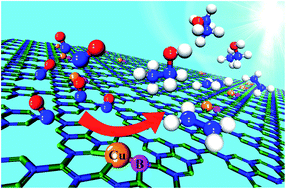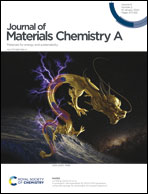Atomically dispersed asymmetric Cu–B pair on 2D carbon nitride synergistically boosts the conversion of CO into C2 products†
Abstract
The deeper reduction of CO to multi-carbon-based fuels with higher energy densities and wider applicability has recently triggered extensive experimental and theoretical research. However, present-day catalysts for the generation of multi-carbon products (C2+) suffer from ultra-high energy barrier for C–C bond formation and poor selectivity, which poses great challenges for practical application. Herein, we propose and evidence with first-principles calculations a novel catalyst for the conversion of CO into more value-added ethylene and ethanol under visible light, consisting of active Cu–B atomic pair decorated graphitic carbon nitride (Cu–B@g-C3N4). Our results show that the low coordinated Cu–B atomic pair anchored on g-C3N4 could effectively reduce the CO dimerization free energy barrier to a record value of 0.63 eV. This high catalytic performance stems from the moderate binding strength of the intermediates modulated by the asymmetric synergy of the atomically dispersed metal Cu and non-metal B that can break the linear scaling relationship of traditional transitional metal catalysts. Moreover, the low-coordinated Cu–B active site with synergistic d–p coupling can significantly suppress the parasitic hydrogen evolution reaction. Compared to pure g-C3N4, the Cu–B@g-C3N4 catalyst also becomes more optically active under visible and even infrared light. Ab initio molecular dynamics simulations suggest that the Cu–B@g-C3N4 catalyst possesses a high thermal stability. Considering that efficient catalysts for C2+ production are currently essentially limited to Cu-bimetallic systems, our work highlights a fully new concept towards the development of novel CO reduction catalysts based on synergistic coupling between metal Cu and non-metal atoms.

- This article is part of the themed collection: 2020 Journal of Materials Chemistry A most popular articles


 Please wait while we load your content...
Please wait while we load your content...